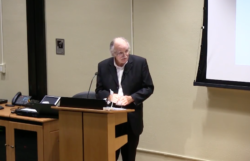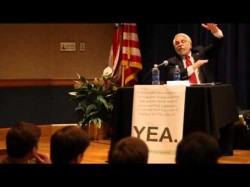Doing Two Things at Once: Jobs and Housing as Routes Out of Recession?
Maybe it’s because of what I see every morning from my kitchen window– the view over coffee of my former neighbor’s foreclosed and rapidly deteriorating home – that the Obama Administration’s housing policy so depresses me. Or maybe what depresses me is the housing policy itself.
The house is visibly rotting before my eyes. The weeds are now growing through the middle of the air-conditioning units. The gutter no longer links directly to the downspout. The fascia boards are succumbing to the carpenter bees. Like any house unoccupied and unloved, what I see each morning is a rapidly deteriorating building that once physically embodied the hopes of everyone who lived inside it – owned now, no doubt, by a bank that is apparently too busy or too casual even to maintain its upkeep. What I see each morning stands as a daily reminder of the scale and character of the recession that still besets us. What I see each morning reminds me that we are currently suffering not just a jobs crisis but also a crisis of homes. People have lost more than paid work in this recession, though many of them have certainly lost that. They have also lost dreams.
The President seems to be willing at last to campaign actively on the issue of jobs, but on the issue of housing even his rhetoric remains inadequate. So far at least, any aid provided to struggling house owners by this administration remains too little, too late and too uncelebrated.[1] The new aid now being proposed was characteristically tucked away as a minor detail in the long body of the address made to a joint session of Congress on September 8th. Repeatedly in that address, the president called for the immediate passage of the Jobs Act; but just once, two-thirds into his peroration, did he mention housing – and then only briefly. In a section of the address that was actually focused on business deregulation, the President added: “and to help responsible homeowners, we’re going to work with federal housing agencies to help more people refinance their mortgages at interest rates that are now near 4 percent.”
Was that an adequate response to the scale of the crisis now facing American home-owners? No it was not. It was not even close. Even the London Financial Times called it “vague” and “surprising for its low profile.”[2]
The vagueness is indeed surprising when you look at the numbers, because the housing numbers are appalling and speak of vast amounts of human suffering.[3] “Almost 6.7 million U.S. homes were lost to foreclosure, short sales or turned back to lenders between 2000 and 2010, according to Moody Analytics.” 3.5 million of those homes were lost after December 2007; and “another 3.6 million could meet the same fate through 2013.”[4] Home foreclosures topped the million mark for the first time in 2010. There were 225,000 foreclosure filings in February 2011 alone.[5] In spite of historically low mortgage rates – in August 2011, at 4.15% for a 30 fixed rate mortgage, the rate was at a 50 year low – the proportion of adult Americans now owning their own home has fallen back to 1998 levels: down from 67.2% in the first quarter of 2010 to 66.5% in the first quarter of 2011.[6] Moreover, 18% of home owners with a single mortgage on their house, and a staggering 38% of those with second mortgages, are currently under-water: the amount left to be paid on their mortgage, that is, being actually greater than the value of the house whose purchase it originally financed.[7] As a result, and according to:
“…estimates from the Mortgage Bankers Association [October 2010], approximately 4.1 million borrowers are in foreclosure or near it, the latter being borrowers who are more than 90 days delinquent on their mortgage. Together, these two groups of borrowers are sometimes called ‘seriously delinquent.’ Both in absolute terms and as a proportion of outstanding mortgages, serious delinquencies remain near record highs.”[8]
That number – 4.1 million borrowers – takes in nearly one homeowner in 10 – and does so at a time when Fannie Mae and Freddie Mac are both government-controlled, when they together now own approximately half of all unsold repossessed properties (some 250,000 homes) and when “another 830,000 homes backed by the entities are in some stage of foreclosure.”[9] As an accidental by-product of a policy decision taken by the Bush Administration at the height of the financial crisis in September 2008, the federal government now has an effective policy tool in its direct grasp – a policy tool through which to address the housing crisis without having to seek new powers from a gridlocked Congress. It is a policy tool, however, that the Obama administration has thus far chosen to wield only modestly and to very little effect.
Why?
Well, initially partly because of moral hazard concerns. The original HAMP[10] proposals (in February 2009) were drafted and introduced when the popular understanding of the housing crisis was that it was almost exclusively a subprime mortgage one. People were in difficulty, suddenly unable to pay their mortgages, primarily because they had taken out over-ambitious loans. Helping them would therefore be a slap in the face to more sensible home-owners, the ones with the wisdom not to over-extend themselves. As the President put it when introducing HAMP:
I want to be very clear about what this plan will not do. It will not rescue the unscrupulous or irresponsible by throwing good taxpayer money after bad loans. It will not help speculators who took risky bets on a rising market and bought homes not to live in but to sell. It will not help dishonest lenders who distorted the facts…and it will not reward folks who bought homes they knew from the beginning they would never be able to afford….This plan will not save every home.
That mode of argumentation was problematic even in 2009, because even initially the foreclosure crisis was so much more than a crisis of sub-prime lending. The original foreclosure crisis was triggered as much by the non-payment of traditional mortgages (and of equity loans – we must never forget the role played then, and still played now, by second-liens[11]) as it was one triggered by low-income families trying to slip into the bottom of the U.S. home ownership system. And even if we allow that there was a significant subprime dimension to the original foreclosure crisis, the Administration’s 2009 failure to help sufficient numbers of stressed mortgage payers still ultimately hurt all those paying a mortgage, and not just those ejected from their homes. It left all home-owners with deflated property prices;[12] plus – as here with me – the painful loss of neighbors whose only crime was to earn a low wage while trying to better the living conditions of their families. The moral hazard case was oversold even when there was some justification for it.
But that was then and this is now. Moral hazard arguments have no place at all in the current policy debate: because today’s debate is one about a housing crisis in which people’s inability to pay their monthly mortgage is overwhelmingly the result of their involuntary unemployment, and is not the product of any fecklessness on their part. A housing crisis rooted in large scale involuntary unemployment requires more than a jobs bill, welcome as that is. What it also requires are changes to the rules governing housing finance, changes that will enable mortgagees in trouble to remain in their houses – paying for them in some different fashion,[13] or renting them and sharing any long-term capital gain with the federal government: sharing those gains, that is, with the U.S. taxpayer whose support, if properly targeted, would easily keep them there.[14]
An administration that can bail out big banks should be able with even greater ease to bail out small home-owners. An administration willing to pick up the tab for 85% of the costs of drawing toxic assets out of financial institutions whose feckless acquisition of those assets had made them potentially insolvent, ought to have the capacity to pick up the much smaller tab on private mortgages that are temporarily beyond the financial capacity of low-waged and unemployed Americans. The Administration ought to have that capacity and it ought to use it, particularly given that those low-paid and unemployed Americans are entirely innocent of any causal responsibility for their own precarious employment and housing condition.
Maybe there are favorable straws in the wind. The address to the joint session of Congress did certainly mark a shift in Administration policy on housing from as recently as February 2011, when the long awaited white paper, Reforming America’s Housing Finance Market: A Report to Congress, proposed the eventual elimination of Fannie and Freddie.[15] The President does now seem willing to use the two GSEs for direct intervention in the housing market, and has publicly conceded the inadequacy of existing policy – the need to go back to the drawing board.[16] Indeed, as recently as mid-August, reports surfaced in the national press of a looming and major change in housing policy, a change designed precisely to keep more people in their homes.[17] No such major change has yet occurred, however, blocked – it would appear – by disagreements inside the Administration, disagreements within which conservative voices within the Federal Housing Finance Agency overseeing Fannie and Freddie have so far prevailed.[18] If those voices have prevailed, and if they continue to prevail, that will be a truly tragic outcome which we must continue to challenge.
For it is this kind of conservatism within the Administration that has led it thus far to waste every opportunity to fully control U.S. finance, and would appear now to be undermining its capacity to mobilize that finance on behalf of American homeowners. Such conservatism makes no moral sense, no economic sense, and no political sense either. The moral case against involuntary homelessness is obvious; and so too should be the economic one. With more and more Americans fearing the loss of their homes, a depressed housing market will continue to drag down the recovery rate of the rest of the U.S. economy. A jobs bill without a housing bill will produce neither rapid employment growth nor a return to confidence among American consumers, and the Obama people ought to be intelligent enough to realize that.
A jobs bill without a housing bill will also not keep Obama in the White House for a second term; and we do need him to win in November 2012. So please, will somebody wake up the White House. If they want to keep their jobs and that House, they need to make sure that mainstream America keeps plenty of both their jobs and their houses. Surely it is possible for a team as talented as Obama’s to do two things at once. At least it should be possible for them to make a better attempt at twin-tracking than they are currently managing.
[1] See “As Housing Goes, So Goes the Economy,” The New York Times, May 24, 2011, available at http://www.nytimes.com/2011/05/25/opinion/25wed1.html; and Andrew Martin, “For the Jobless, Little U.S. Help on Foreclosure,” The New York Times, June 4, 2011, available at http://www.nytimes.com/2011/06/05/business/economy/05housing.html?pagewanted=all. For ealier commentary, see https://www.davidcoates.net/2010/08/01/the-foreclosure-crisis-that-will-not-go-away/; https://www.davidcoates.net/2010/05/07/the-foreclosure-crisis/ and https://www.davidcoates.net/2010/01/30/the-housing-policy-in-2009/
[2] Robin Harding and Tom Braithwaite, “White House short on options for housing debt,” The Financial Times, September 13, 2011.
[3] For the adverse effect of foreclosure on mental and physical health, see Janet Currie and Erdal Tekin, Is the Foreclosure Crisis Making Us Sick? NBER Working Paper No. 17310, August 2011, available at http://www.nber.org/papers/w17310.pdf. For the adverse effect of negative equity on labor mobility, see Fernando Ferreira, Joseph Gyourko and Joseph Tracy, Housing Busts and Household Mobility, NBER Working Paper No 17405, September 2011, available at http://www.nber.org/papers/w14310.pdf
[4] Alan Zibel and Louise Radnofsky, “Only 1 in 4 Got Mortgage Relief,” The Wall Street Journal, February 28 2011, available at http://online.wsj.com/article/SB10001424052748704692904576166982594828812.html . See also “Foreclosure Follies,”The New York Times, March 3, 2011, available at http://www.nytimes.com/2011/03/04/opinion/04fri1.html.
[5] Michael Powell and Andrew Martin, “Foreclosure Aid Fell Short, and Is Fading,” The New York Times, March 29 2011, available at http://www.nytimes.com/2011/03/30/business/30foreclose.html?pagewanted=all.
[6] “Home Ownership Rate Drops to 1998 Level,” The Wall Street Journal, May 24, 2011, available at http://blogs.wsj.com/developments/2011/04/27/homeownership-rate-drops-to-1998-level.
[7] Robbie Whelan, “Second-Mortgage Misery,” The Wall Street Journal, June 7, 201,available at http://online.wsj.com/article/SB10001424052702304906004576369844062260756.html.
[8] Guhan Venkatu, Out of the Shadows: Projected Levels for Future REO Inventory, Federal Reserve Bank of Cleveland: http://www.clevelandfed.org retrieved October 20, 2010.
[9] Nick Timiraos, “U.S. Weighs Renting Out Foreclosed Homes,” The Wall Street Journal, August 10, 2011, available at http://online.wsj.com/article/SB10001424053111904480904576498713414380604.html
[10] The Home Affordable Modification Program
[11] See Alex Ulam, “The Next Big Housing Crisis?” The Nation, April 4, 2011, available at http://www.thenation.com/article/159281/next-big-housing-crisis.
[12] See Atif Mian, Amir Sufi and Francesco Trebbi, Foreclosures, House Price and the Real Economy, NBER Working Paper 16685, January 2011, available at http://www.nber.org/papers/w16685.pdf.
[13] For the argument that the government should offer a 3% fixed-rate thirty-year mortgage to everyone regardless of credit-worthiness, see John R. Talbott, How Obama Can Fix the Housing Market and the Economy: posted on The Huffington Post, June 26, 2011 and available at: http://www.huffingtonpost.com/john-r-talbott/how-obama-can-fix-the-hou_b_884890.html
[14] See Dean Baker, Right to Rent: Will the Obama Administration Finally Fix Housing? posted on The Huffington Post, June 27, 2011 and available at: http://www.huffingtonpost.com/dean-baker/obama-housing-market_b_885748.html
[15] For commentary on that white paper, see https://www.davidcoates.net/2011/02/13/obama-and-housing-%E2%80%93-is-anybody-home/
[16] Nick Timiraos, “U.S. Tackles Housing Slump,” The Wall Street Journal, July 12, 2011, available at http://online.wsj.com/article/SB10001424052702304584404576440033488980192.html.
[17] See Margaret Chadbourn, Obama Mortgage Relief Program To Reduce Foreclosures May Be Unveiled Next Week, posted on The Huffington Post August 31, 2011: and available at http://www.huffingtonpost.com/2011/08/31/obama-mortgage-relief-foreclosures_n_943061.html. See also Zachary A. Goldfarb, “On mortgage rates, Obama wants proposal for how government can keep big role,” The Washington Post, August 15, 2011, available at http://www.washingtonpost.com/business/economy/on-mortgage-rates-government-should-keep-significant-role-obama-says/2011/08/15/gIQA8wP0HJ_story.html.
[18] Details in Harding and Braithwaite, op.cit; Goldfarb, op.cit; and Nick Tmiraos, “Uncle Sam Weighs Landlord Role to Ease Housing Slump,” The Wall Street Journal, July 22, 2011, available at http://article.wn.com/view/2011/07/22/Uncle_Sam_Weighs_Landlord_Role_to_Ease_Housing_Slump/
Tags: foreclosures, housing crisis, housing policy, Jobs Act
David Coates holds the Worrell Chair in Anglo-American Studies at Wake Forest University. He is the author of Answering Back: Liberal Responses to Conservative Arguments, New York: Continuum Books, 2010.
He writes here in a personal capacity.






Richard Stark says:
I found one of the best political economists at REVCOM.US and he is Bob Avakian. You can have a look at bobavakian.net as well.
I worked with the Bertrand Russell Peace foundation for a time in the sixties. He was still alive, and very cogent indeed!
I much like the work of Raymond Lotta whose book AMERICA IN DECLINE, (1986), written with Frank Shannon is really one of the very greatest books on political economy I’ve yet encountered. Best, R
David Coates says:
Thanks Richard. I will hunt out Bob’s work and the Lotta & Shannon study. Much appreciated! David
Patricia Dixon says:
David:
I am seeing the same thing you see out your window, my neighbor’s house in total disrepair, there are small trees growing in the gutters and the city was called to clean up the yard because another “right wing neighbor” could not stand the site from her pristine lawn.
I ask myself is this the promise of the American Dream?
The president is not doing enough, the housing problem is very serious and many people are joining the millions that live in poverty. We need a Job and a Housing bill, plus a bill that will prohibit government bailout for financial institutions.
David Coates: Helping Obama Rediscover His Groove | Politimo says:
[…] program too sweeping, and his reticence on the housing crisis too crushing to the hopes of so many. But the campaigning tone is returning, and with it the possibility of calling Obama back from his […]
Helping Obama Rediscover His Groove | Elections News says:
[…] program too sweeping, and his reticence on the housing crisis too crushing to the hopes of so many. But the campaigning tone is returning, and with it the possibility of calling Obama back from his […]